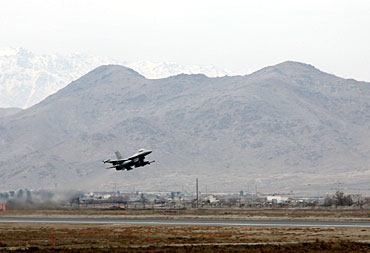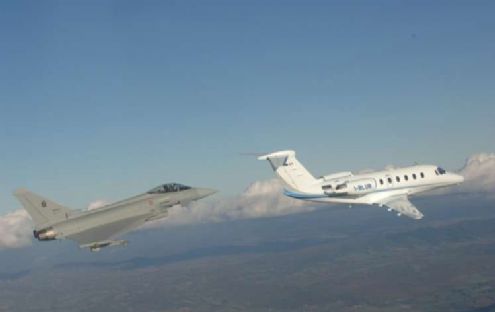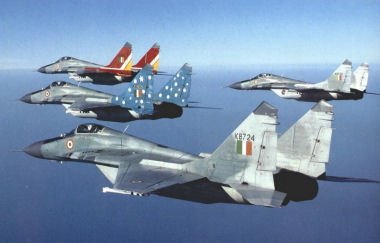Military aviation news - February 2006
U.S. Air Force awards Lockheed Martin $68 million contract to provide C-130J weapons systems trainers
Orlando, FL, February 22, 2006 -- The U.S. Air Force has awarded Lockheed Martin (NYSE: LMT) a $68 million contract to provide Weapons Systems Trainers (WST) to support the service’s C-130J and the U.S. Marine Corps KC-130J aircraft.
Under the contract, the Air Force will receive two trainers and the U.S. Marine Corps will receive one trainer. The WST will provide training for Air Force aircrews who fly the C-130J — the latest version of the medium-lift transport aircraft in service with the U.S. Air Force for nearly four decades.
The KC-130J is used by the U.S. Marine Corps for aerial refueling and troop transport. The C-130J and KC-130J incorporate state-of-the-art technology to reduce manpower requirements, lower operating and support costs and provide life-cycle cost savings over earlier C-130 models.
“The Weapons Systems Trainer is part of a total training program that graduates mission-qualified C-130 aircrews,” said Lorraine Martin, vice president of Lockheed Martin Simulation, Training & Support Flight Solutions. “Aircrews are immersed in a variety of scenarios that allow them to hone their skills. They can prepare for a variety of missions without actually flying the aircraft. This reduces costs, and delivers a safe, effective training solution to our customers.”
Design and manufacture of the Weapons Systems Trainers is part of Lockheed Martin’s C-130J Maintenance and Aircrew Training System (JMATS) program. The program provides a comprehensive range of training devices and training support services including aircrew instruction, operations, contractor logistics support and engineering services. Design and manufacture of the trainers has been subcontracted to CAE.
Posted: Thu, Feb 23, 2006 20:48 (CET)
Busy Year for Eurofighter Typhoon - Flight Test Programme in Final Stages
A busy year lies ahead for the four national Eurofighter Typhoon team, as the programme has entered the final stages of the main development with more than two thirds of the flight test programme achieved so far. The testing of the air-to-air carefree handling Flight Control System software is almost finished, the last clearances for the so called Phase 4 software, necessary for the Block 2B standard aircraft will be finalized over summer.
A new chapter in Eurofighter Typhoon’s development has now been entered with testing of the air-to-ground Flight Control Software. This FCS Phase 5 software, written by a Joint Team headed by EADS Military Air Systems in Germany, will over the next months undergo rigorous testing in all four partner nations and will involve six aircraft for testing and validating the data required for the required clearances.
Development Aircraft DA2 in the UK will be conducting carefree handling tests, low speed flying, asymmetrical loads in spring 2006. This aircraft has been picked for these challenging tests, as it is the only test aircraft to be flown with an anti-spin gantry to prevent the aircraft from departure in extreme flight maneuvers.
DA3 at Alenia Finmeccanica in Italy will do performance testing in respect to lift and drag, but also will jettison air-to-ground weapons in summer.
More information and pictures at eurofighter.com
Posted: Tue, Feb 20, 2006 22:56 (CET)
Norway signs contract for JDAM
The Boeing Company will provide the Joint Direct Attack Munition (JDAM) weapon system to the Royal Norwegian Air Force (RNoAF) under an agreement recently reached with Norway.

A Norwegian F-16A MLU taking off in Afghanistan.
The JDAM system will equip RNoAF F-16 aircraft with all-weather, autonomous, accurate delivery of bombs against a broad spectrum of targets. The contract includes JDAM guidance kits, F-16 weapon system integration and operational support.
Full story at F-16.net
Posted: Tue, Feb 20, 2006 22:44 (CET)
Italian Eurofighter Typhoons Providing Air Cover for Turin Winter Olympics
Following the commencement of operations in its Air Surveillance role with the Italian Air Force on December 16 2005, the Eurofighter Typhoon new generation combat aircraft has been tasked with providing airspace air defence coverage above Turin during the Winter Olympic Games over the next two weeks.

Italian Air Force Eurofighter Typhoon, from 4 Stormo at Grosseto, defending the airspace over Turin during the Winter Olympics.
The Eurofighter Typhoon is already in operation as part of the Italian integrated air defence system from the main base of Grosseto, home of 4° Stormo. The Aeronautica Militare is the first air force in the world to operate the Eurofighter Typhoon aircraft in a real operational scenario.
The new Italian Eurofighter Typhoons form part of an air defence structure which has already been tested during events such as the Genoa G8 summit, Pratica di Mare NATO-Russia summit, the burial ceremony for Pope John Paul II and the coming into seat of Pope Benedictus XVI.
The Eurofighter Typhoon will be deployed over Turin together with the Italian Air Force F-16 as well as the MB-339CD and the HH-3F helicopter.
Full story and more images at Eurofighter.com
Posted: Tue, Feb 14, 2006 16:43 (CET)
RSK MiG to upgrade India's MiG-29 fighters in $888m deal
RSK MiG has signed an $888 million deal with the Indian defence ministry to upgrade the country's air force’s fleet of 67 MiG-29s. The Indian air force has been studying fighter fleet modernisation for several years and has considered various options. The deal is understood to have received financial approval from the Indian government in its 2006-7 budget.

This quartet of Indian MiG-29s is drawn from Nos 28 and 47 Squadrons. Coloured tail units are used to differentiate friend from foe during non-dissimilar air combat training. Each aircraft carries an R-60 AA-8 'Aphid' acquisition round.
It is unclear which upgrade the deal covers, with the MiG-29SMT configuration developed for Malaysia one option or the MiG-29MRCA including Phazotron-NIIR's Kopyo or Zhuk-M radar also considered likely. Any upgrade would take place over the next four years and extend the life of the aircraft by around 15 years. The MiG-29s will also be upgraded for in-flight refuelling.
The air force is currently upgrading 125 MiG-21s and 40 MiG-27ML fighters with combat avionics, with work carried out in the air force's maintenance centre at Nasik air base in western India by state-owned Hindustan Aeronautics. Around 94 of 125 MiG-21s have been upgraded to the MiG 21 Bison standard, with the remaining 29 jets to be modernised by the end of the year.
Full story at Flight International.com
